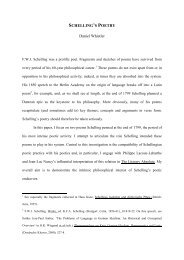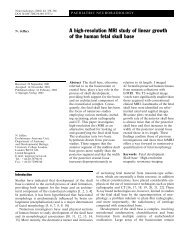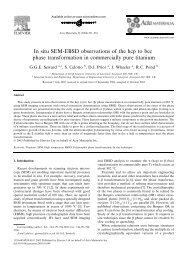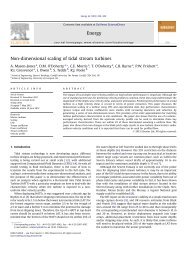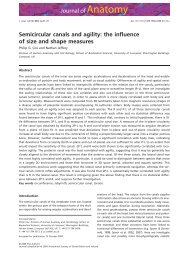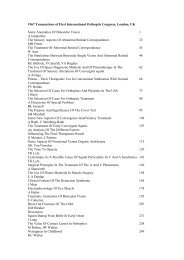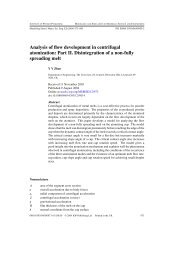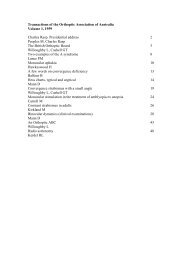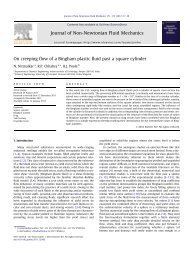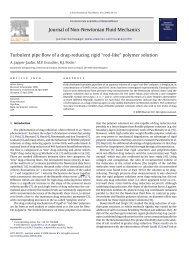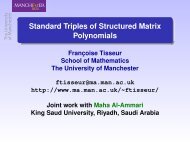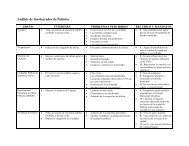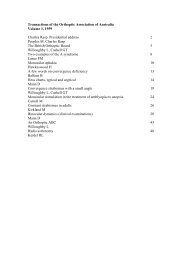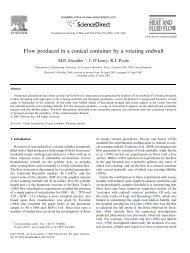Beyond the Pre-Pottery Neolithic B interaction sphere - University of ...
Beyond the Pre-Pottery Neolithic B interaction sphere - University of ...
Beyond the Pre-Pottery Neolithic B interaction sphere - University of ...
You also want an ePaper? Increase the reach of your titles
YUMPU automatically turns print PDFs into web optimized ePapers that Google loves.
88 J World <strong>Pre</strong>hist (2006) 20:87–126<br />
restructuring in response to sedentism and to <strong>the</strong> new economic conditions (for useful<br />
overviews, see Moore, 1989; Harris, 1996, pp. 552–573). O<strong>the</strong>r likely explanatory factors<br />
include modes <strong>of</strong> socio-cultural <strong>interaction</strong> between hunter-ga<strong>the</strong>rers and cultivators such as<br />
<strong>the</strong> adoption <strong>of</strong> <strong>the</strong> new economy by indigenous populations (acculturation) and <strong>the</strong><br />
transference <strong>of</strong> means <strong>of</strong> production and technological innovations via population movements<br />
(demic diffusion) (Cavalli-Sforza, 2002; Burmeister, 2000).<br />
Drawing from culture-historical approaches and <strong>the</strong> tenets <strong>of</strong> Darwinian evolutionary<br />
biology, Shennan (2000) has put forward an alternative neo-evolutionary model for <strong>the</strong><br />
interpretation <strong>of</strong> culture change based on <strong>the</strong> principle <strong>of</strong> ‘‘descent-with-modification’’.<br />
This views cultural transitions in prehistoric non-state societies as <strong>the</strong> outcome <strong>of</strong> systemic<br />
<strong>interaction</strong>s between population dynamics, intra-group cultural transmission mechanisms<br />
and stochastic change. In addition to <strong>the</strong>se, recent syn<strong>the</strong>tic research on specific case<br />
studies has described population movements and <strong>the</strong> colonization <strong>of</strong> new areas as processes<br />
involving complex and geographically highly contingent socio-cultural adjustments<br />
(Broodbank, 2000; Perlès, 2001).<br />
In Western Asia, <strong>the</strong> Early <strong>Neolithic</strong> broadly falls within <strong>the</strong> eleventh to seventh millennia<br />
cal. BC (Table 1; Fig. 1) during which agricultural economies became consolidated.<br />
This is generally viewed as a period <strong>of</strong> prolonged cultural development. The variability <strong>of</strong><br />
<strong>the</strong> <strong>Pre</strong>-<strong>Pottery</strong> <strong>Neolithic</strong> A and <strong>the</strong> preceding Epipalaeolithic (both terms are used here as<br />
chronological indicators) as seen in site size and structure, architecture, settlement patterns<br />
and subsistence practices inter alia, was replaced during <strong>the</strong> ninth and eighth millennia BC<br />
by <strong>the</strong> ‘‘PPNB <strong>interaction</strong> <strong>sphere</strong>’’ (Bar-Yosef & Belfer-Cohen, 1989; Bar-Yosef &<br />
Meadow, 1995; see also Fig. 2). This saw a pr<strong>of</strong>usion <strong>of</strong> symbolic expression, and settlement<br />
expansion within and adjacent to <strong>the</strong> core area <strong>of</strong> socio-economic innovations: <strong>the</strong><br />
‘‘Levantine Corridor’’, a belt <strong>of</strong> alluvial habitats stretching from <strong>the</strong> Jordan river to <strong>the</strong><br />
Damascus oasis and <strong>the</strong> upper Euphrates, and encompassing parts <strong>of</strong> modern Jordan,<br />
Palestine, Israel, Syria and sou<strong>the</strong>ast Turkey (Fig. 3). Some have described <strong>the</strong> PPNB <strong>of</strong><br />
Western Asia as <strong>the</strong> first archaeologically documented occurrence <strong>of</strong> a pan-regional culture<br />
involving such developments as <strong>the</strong> emergence <strong>of</strong> a new religion, centred on <strong>the</strong> archetypal<br />
symbols <strong>of</strong> <strong>the</strong> ‘‘female and <strong>the</strong> bull’’, and <strong>of</strong> <strong>interaction</strong> <strong>sphere</strong>s characterized by shared<br />
material practices, cultural emulation and <strong>the</strong> intensification <strong>of</strong> exchange networks, while<br />
at <strong>the</strong> same time displaying clear regional characteristics (Bar-Yosef & Belfer-Cohen,<br />
1989; Bar-Yosef & Meadow, 1995; Cauvin, 2000; Watkins, 2003). O<strong>the</strong>rs have argued,<br />
instead, in favour <strong>of</strong> a much greater degree <strong>of</strong> regional differentiation by pointing out <strong>the</strong><br />
persistent variability in settlement patterns, architecture and subsistence practices<br />
(Rollefson, 2004) and <strong>the</strong> regional differences in ritual expression and socio-political<br />
organization as ways <strong>of</strong> negotiating community cohesion and group identity (Kuijt, 2000a;<br />
Asouti, 2005). Despite local variations, a number <strong>of</strong> region-wide commonalities reinforce<br />
our perception <strong>of</strong> <strong>the</strong> PPNB less as a mere chronological horizon and more as a widespread<br />
Table 1 Generalized regional chronology for <strong>the</strong> Early <strong>Neolithic</strong> (PPN) <strong>of</strong> Western Asia<br />
Chronological/cultural horizon Dates (cal. BC)<br />
<strong>Pre</strong>-<strong>Pottery</strong> <strong>Neolithic</strong> A *10,500–9200<br />
Early PPNB *9200–8300<br />
Middle PPNB *8400–7500<br />
Late PPNB-PPNC/LN *7500–6000<br />
Source: Aurenche et al. (2001)<br />
123



